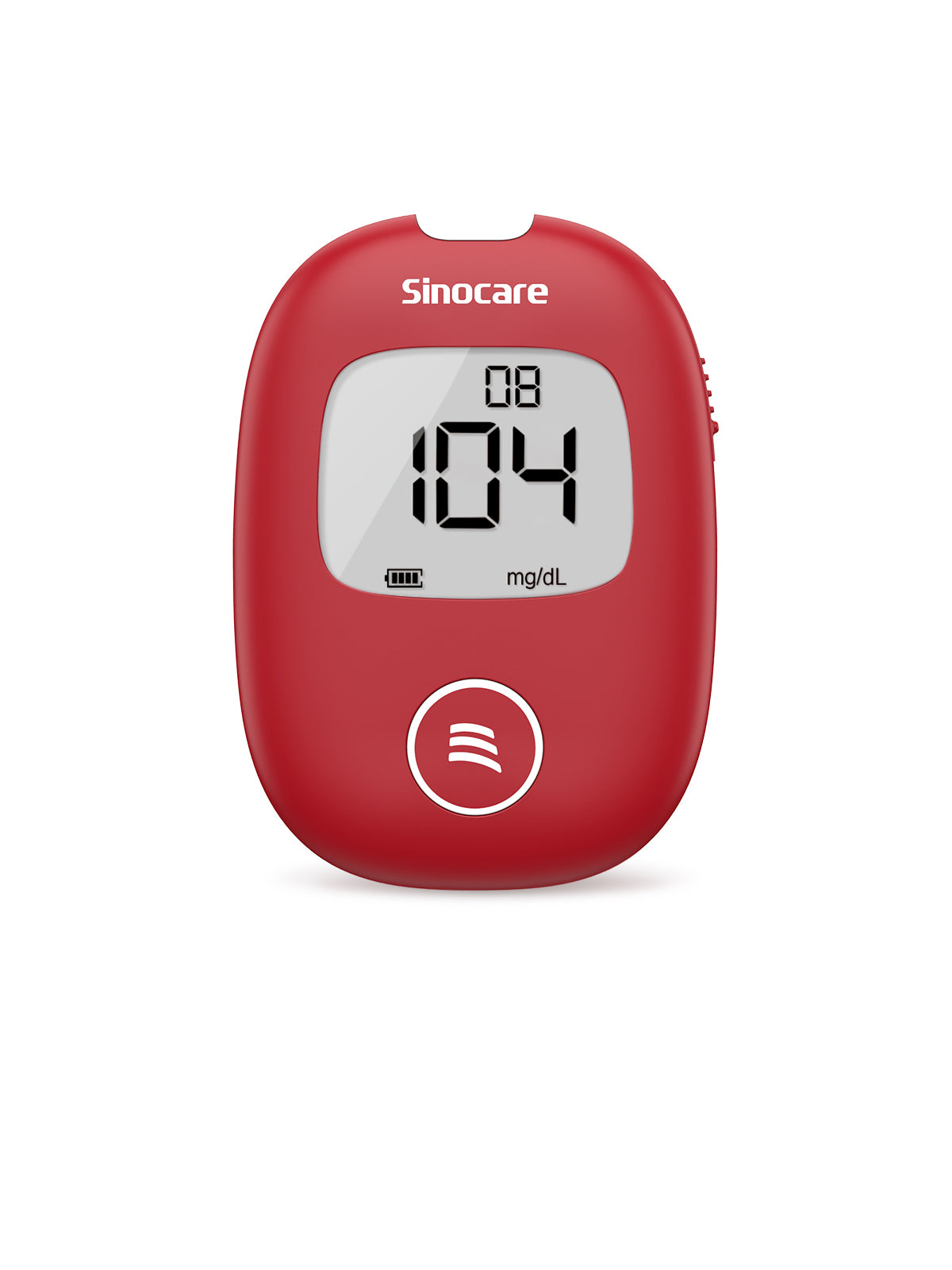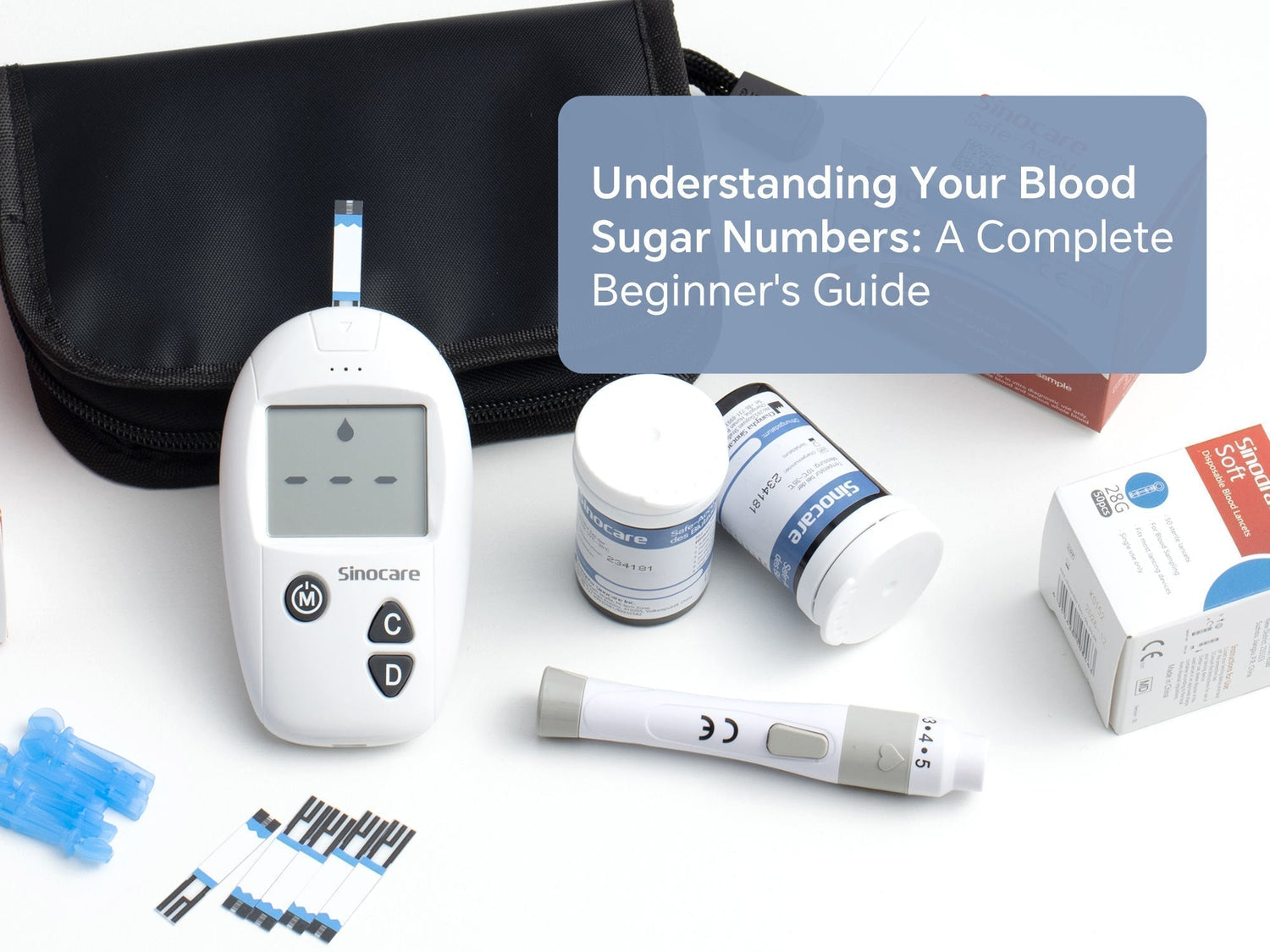If you’re new to tracking your blood sugar, the numbers you see on your glucometer can be confusing. You might feel like seeing the answer to a math puzzle but have no clue how the solution was cracked. What is a “normal” reading? What do mg/dL or mmol/L mean? What about terms like fasting blood sugar or A1C?
This beginner’s guide will help you break down the readings on your glucometer and understand what they mean — what’s normal, what’s prediabetes or diabetes and what actions you can take.
Blood Sugar Basics: What Is It and How Is It Measured?
Blood sugar is simply the amount of glucose in your bloodstream. It's measured in either milligrams per deciliter (mg/dL) or millimoles per liter (mmol/L). In most countries of the world, the mmol/L unit is used while mg/dL is used primarily in the U.S [1].
There is a simple formula to convert mmol/L into mg/dL: mmol/L × 18 = mg/dL. For example, a glucose level of 5.5 mmol/L is the same as about 100 mg/dL (5.5 × 18 = 99).
Doctors typically check blood sugar using some common tests. They may use a quick finger-prick glucometer like Sinocare Safe AQ Smart or laboratory blood tests. These tests can be performed under different conditions, such as fasting (after not eating overnight), preprandial (before a meal) or postprandial (after a meal) [1, 2].
Common Tests to Measure Blood Sugar
-Fasting Plasma Glucose (FPG): measured after an overnight fast of at least 8 hours without food.
- Oral Glucose Tolerance Test (OGTT): after fasting overnight, 75 g of glucose is ingested, and then blood sugar is measured 2 hours later. This test shows if your body can process glucose as it normally would.
- Hemoglobin A1C (HbA1c): blood draw can happen at any time; shows average level of glucose in your blood over the past 2-3 months; usually expressed as a percentage.
- Random Blood Sugar: any time of day; if ≥200 mg/dL (11.1 mmol/L) with classic symptoms, may indicate diabetes, but it requires confirmation with another test [3, 4]
Blood Sugar Level Chart

Note: The above chart is based on data provided by the U.S. Centers for Disease Control and Prevention (CDC) and American Diabetes Association (ADA). This chart applies to everyone except pregnant women and children [5, 6].
How to Interpret This Chart
The values in the “Normal” column are those you’re likely to see in someone without diabetes. In healthy adults, blood sugar usually stays below 100 mg/dL (5.5 mmol/L) after overnight fasting. It rises for a couple of hours after a meal, but even then it remains under ~140 mg/dL (7.8 mmol/L) at about 2 hours [5].
When blood sugar levels are higher than normal but not yet in the diabetic range, this state is called prediabetes. If your values consistently fall into the “Prediabetes” column, it’s a red flag. You should take steps to improve your blood sugar or talk to your doctor. If any value is in the “Diabetes” range, your doctor may repeat the same test or order additional tests to confirm a diabetes diagnosis [4, 5].
Readings in Daily Life: Blood Glucose Targets and Ranges

Note: The above chart is based on data from the CDC and the ADA. It applies to most adults with diabetes, except for pregnant women. Do, remember these targets can vary from person to person. Older adults and those with pregnancy or other health conditions may have slightly higher target ranges. Also, bedtime targets are often individualized. Always personalize your blood sugar targets with your healthcare provider’s advice [3, 5, 6].
How to Interpret the Chart in Daily Life
Readings less than 70 mg/dL (3.9 mmol/L) indicate hypoglycemia (low blood sugar) and should be treated immediately using fast-acting carbs. If the reading is < 90 mg/dL (5.0 mmol/L) at bedtime, you may need a snack to avoid overnight hypoglycemia. Readings above your target range indicate hyperglycemia (high blood sugar). Seek medical advice if your blood sugar level remains high even after taking your prescribed medications and/or insulin [7].
In normal individuals, blood sugar usually peaks but stays below 140 mg/dL (7.8 mmol/L) two hours after eating. Often it returns to under 120 mg/dL (6.6 mmol/L) by that time. If you’re in the prediabetes stage, your postprandial readings might be a bit higher. For example, at 1 hour you might see readings over 140 mg/dL, and at 2 hours you might still be in the same range [4, 5].
In those with diabetes, readings taken after meals often remain high. It’s common to see readings over 200 mg/dL (11.11 mmol/L) or more after eating unless medications are taken. If you have diabetes, your doctor will help you set postprandial targets. Typically, the goal is to stay under 180 mg/dL (10.0 mmol/L) about 1-2 hours after a meal [3, 5, 6].
Why Blood Sugar Readings Change
Blood sugar doesn’t remain static in our bodies. It naturally goes up and down throughout the day. In fact, the rise and fall of glucose level in the body happens due to various factors:
Food: Blood sugar rises the most when you eat carbohydrates, such as rice, bread, fruit, or sweets. If you eat more carbs than your body can absorb at a time, your blood sugar level will rise. Adding fat, protein and vegetables to your meal, however, slows down the absorption of carbs. So, if you see a higher reading than your target ranges, think about what you ate in the last 1-2 hours [8].
Medication: If you have diabetes, the insulin or oral medications that your doctor prescribed are meant to keep your blood sugar level stable. Missing a dose or taking too little (or too much) can lead to highs or lows in glucometer readings. Also, certain medications such as steroids can cause a spike in the blood sugar level [9].
Physical Activity: You might have noticed that your blood sugar levels drop during exercise or even hours later. That’s because your muscles use glucose for energy during an active workout, lowering the glucose level in your blood. On the flip side, lack of physical activity can lead to higher readings over time [10].
Stress and Illness: If you’re sick (fever, flu, infection) or very stressed, your body will release hormones like cortisol and adrenaline. These hormones can raise your blood sugar levels even if you make no changes in your daily diet and exercise habits [11].
Alcohol: Drinking alcohol can lower blood sugar level, especially if consumed on an empty stomach. But this doesn’t mean alcoholic drinks are beneficial for diabetics. They impair the liver’s ability to release glucose and, in fact, damage the liver [12].
Dawn Phenomenon: Some people wake up with a higher blood sugar reading than they went to bed with. It happens due to the body’s release of hormones like growth hormone or cortisol in the early morning hours. If you’ve experienced this, keep in mind that it’s your body’s hormonal rhythm to blame. But if morning highs are frequent, talk to your doctor [13].
Frequently Asked Questions (FAQs)
What is a normal fasting blood sugar?
For someone without diabetes, a normal fasting blood sugar is typically between about 70 and 99 mg/dL (3.9–5.5 mmol/L). This range is slightly higher in people with diabetes, around 80–130 mg/dL (4.4–7.2 mmol/L). Remember, there is no fixed “normal” range for fasting blood glucose level, but a reading under 100 mg/dL (5.5 mmol/L) is generally considered standard [3, 5, 6].
How long after eating should I check my blood sugar?
Most experts advise taking a blood sugar reading about 1-2 hours after eating a meal. The ADA also suggests checking it at the 2-hour mark to see if your reading is below the postprandial target (often <180 mg/dL or 10.0 mmol/L). But your doctor may suggest different timing depending on your condition [6, 7].
How often should I test as a newly diagnosed type 2 diabetic?
The frequency of blood sugar testing is often therapy-dependent. In general, you may test at least once a day. Increase the frequency if your medications or health changes.
Does glucometer accuracy decline over time?
Yes, accuracy can decrease, especially if the device or the strips are stored inadequately. Perform regular control tests to help maintain reliability.
How Sinocare Can Help
Managing diabetes in daily life gets easier when you have the right tools. Sinocare is a global brand trusted by over 25 million users worldwide. They have a range of blood glucose monitors to meet the unique needs of users. Their glucometers meet international accuracy standards (ISO 15197) and are clinically validated. The testing is typically quick and painless. The test strips are code-free and require only a tiny drop of blood (about 0.6 µL). They deliver results in around 5–10 seconds.
If you prefer a larger screen and clear display, you can go for any Sinocare device without thinking twice, because all their models come with large, backlit screens. Apart from budget-friendly models like Safe Accu, Sinocare has a voice-enabled model, Safe AQ Voice, which can even talk you through the test and read out your results. Their Safe AQ Pro I model has an intelligent color indicator band and a blood ketone reminder (when the reading is ≥13.9 mmol/L). There’s even a 2-in-1 device (Safe AQ UG) that checks blood glucose and uric acid, useful for those also monitoring gout.
Ready to upgrade your meter? Compare Sinocare models to find the best fit for your needs. Already have a Sinocare device? Check out our FAQ page on how to use a Sinocare glucometer, or shop for compatible test strips and lancets on our website.
References
[1]MedlinePlus. (2024, February 28). Managing your blood sugar – patient instructions. U.S. National Library of Medicine. Retrieved from https://medlineplus.gov/ency/patientinstructions/000086.htm.
[2]Patolia, S. K. (2023, May 23). Glucose: Reference range, interpretation, collection and panels. Medscape (eMedicine). Retrieved from https://emedicine.medscape.com/article/2087913-overview
[3]ElSayed, N. A., McCoy, R. G., Aleppo, G., Balapattabi, K., Beverly, E. A., Briggs Early, K., ... & Polsky, S. (2025). 2. Diagnosis and Classification of Diabetes: Standards of Care in Diabetes—2025. Diabetes Care, 48.
[4]Sacks, D. B., Arnold, M., Bakris, G. L., Bruns, D. E., Horvath, A. R., Lernmark, Å., Metzger, B. E., Nathan, D. M., & Kirkman, M. S. (2023). Guidelines and recommendations for laboratory analysis in the diagnosis and management of diabetes mellitus. Diabetes Care, 46(10), e151–e199.
[5]Centers for Disease Control and Prevention. (2024, May 15). Diabetes testing. Retrieved from https://www.cdc.gov/diabetes/diabetes-testing/index.html.
[6]American Diabetes Association. (n.d.). Understanding diabetes diagnosis. In About diabetes. Retrieved from https://diabetes.org/about-diabetes/diagnosis.
[7]American Diabetes Association. (n.d.). Low blood glucose (hypoglycemia). In Living with diabetes. Retrieved from https://diabetes.org/living-with-diabetes/hypoglycemia-low-blood-glucose.
[8]Basturk, B., Ozerson, Z. K., & Yuksel, A. (2021). Evaluation of the effect of macronutrients combination on blood sugar levels in healthy individuals. Iranian Journal of Public Health, 50(2), 280.
[9]Weinberg Sibony, R., Segev, O., Dor, S., & Raz, I. (2023). Drug therapies for diabetes. International Journal of Molecular Sciences, 24(24), 17147.
[10]Helleputte, S., Yardley, J. E., Scott, S. N., Stautemas, J., Jansseune, L., Marlier, J., ... & Calders, P. (2023). Effects of postprandial exercise on blood glucose levels in adults with type 1 diabetes: a review. Diabetologia, 66(7), 1179-1191.
[11]Sharma, K., Akre, S., Chakole, S., Wanjari, M. B., & Wanjari, M. (2022). Stress-induced diabetes: a review. Cureus, 14(9).
[12]MedlinePlus. (2023, May 12). Diabetes and alcohol. In Medical encyclopedia. U.S. National Library of Medicine. Retrieved from https://medlineplus.gov/ency/patientinstructions/000968.htm.
[13]O'Neal, T. B., & Luther, E. E. (2023, May 16). Dawn phenomenon. In StatPearls [Internet]. StatPearls Publishing. Retrieved from https://www.ncbi.nlm.nih.gov/books/NBK430893/.










Leave a comment
All comments are moderated before being published.
This site is protected by hCaptcha and the hCaptcha Privacy Policy and Terms of Service apply.